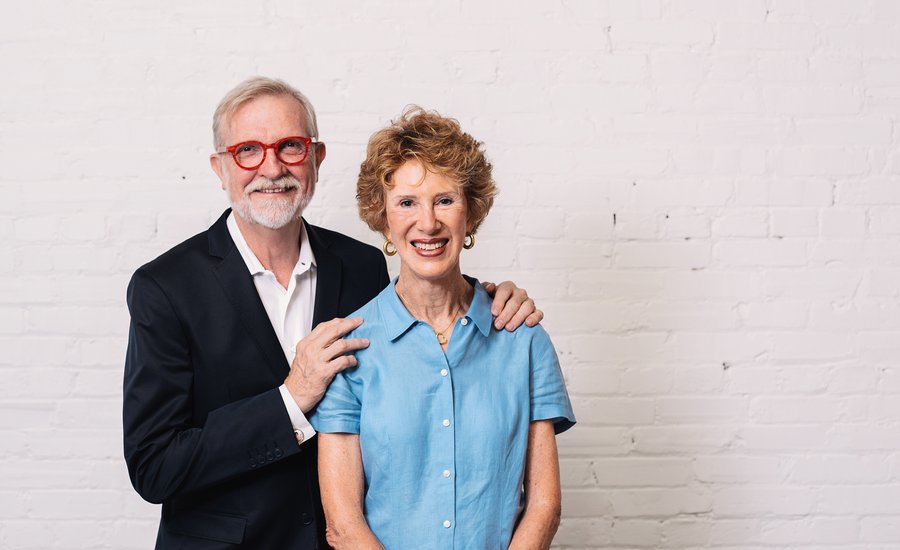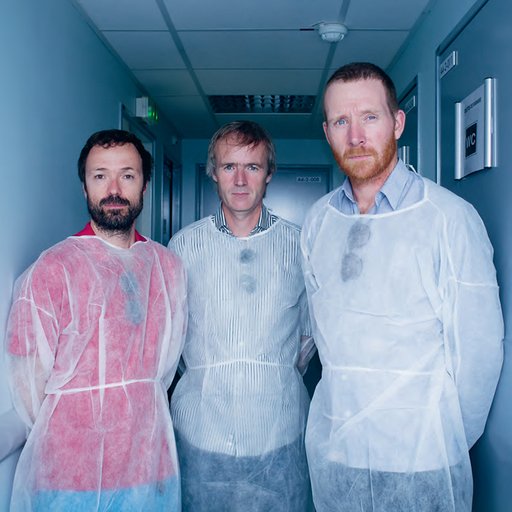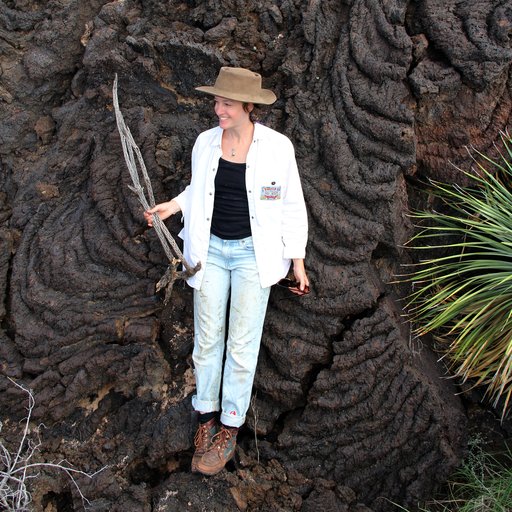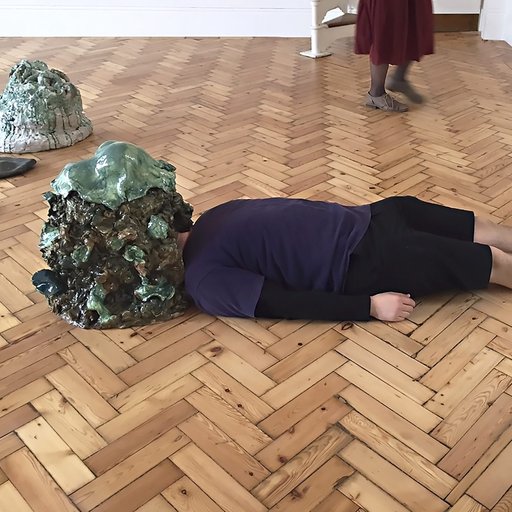In 2006, married art collectors Laura Lee Brown and Steve Wilson opened a risky business in their hometown, a business that combined their interests in art, hospitality, and good food, and that was bound to fail, according to their friends and advisors. Eleven years later, 21c Museum Hotels has added five different U.S. cities to their homebase in Louisville, Kentucky, and is in the process of opening several more. As part of Destinations (a series of guides, interviews, and articles that offer a close look at 3 burgeoning cultural destinations in the US: Louisville, Bentonville, and Nashville), Artspace's editor-and-chief Loney Abrams speaks with Wilson about starting a wildly successful art venture that nobody initially believed in, about inventing a new model for exhibiting art, and about finding the time to race on the US equestrian team.
The first 21c opened in Louisville in 2006. When it opened did you think that you'd end up opening seven more?
No, we did not. We thought we were doing something very risky; our friends, financial advisors, and bankers all thought thought we were crazy. Nobody thought that contemporary art hotel would work, especially not in Louisville, Kentucky. But success came fairly quickly and we were somewhat overwhelmed by it. We only opened number two and three because our partners came to us and asked if we'd be willing to do the same in their hometowns. We said, why not? We had enjoyed doing the first one, we love collecting art, and we love sharing it. Another component of the project is that we like to reinvigorate downtown, city center-type places—old warehouses and what not.
Why do you think people were initially skeptical of combining contemporary art and hospitality?
Many museum professionals are purists and think that it can't be done or it shouldn't be done. They’re fearful of the influence of corporations or sponsorship tainting or influencing curation. And on the other hand, hospitality people don't understand the complication and sophistication of caring for, shipping, insuring, and curating art. There are a lot of great hotels that have great art on the wall, sure—but we don't use art for decoration, we design the spaces to display art. You might see a great Damien Hirst on the wall of a hotel in Miami that’s been put there by a decorator, and it's great to look at but it's going to be there for the next ten years most likely. I don't mean to be critical; I love using art in every way possible and that's certainly better than not using art. But what we do that's different is we curate shows and rotate them. So if someone comes in the space one day, and then comes back six months or a year later, they experience a completely different atmosphere. It keeps it exciting and keeps people coming back. And we tackle social issues that most of corporate America would prefer to not touch. They’d prefer to put a painting of flowers or a still life in a lobby rather than something that might be controversial.
Can you give me an example of either an exhibition or an artwork at 21c that was controversial when you showed it?
Even though we have the rotating exhibition spaces, each property has three to five anchor pieces that become known to the location. Some of those have been on purpose and some of them are accidents. When we opened Louisville we had four of Judy Fox's Children of the World pieces behind the front desk. We really didn't do that to be provocative—but they did cause a stir. There were some letters-to-the-editor but we got past that. Eleven years later, on occasion someone is surprised to see four naked children behind the front desk. But I think when people see something controversial in any piece of art they're bringing some kind of history or background to that. It's in the eyes of the beholder. Judy Fox’s figures are so beautiful and they clearly represent different cultures—so it'd be hard for me to read something sinister into them, but some people do.
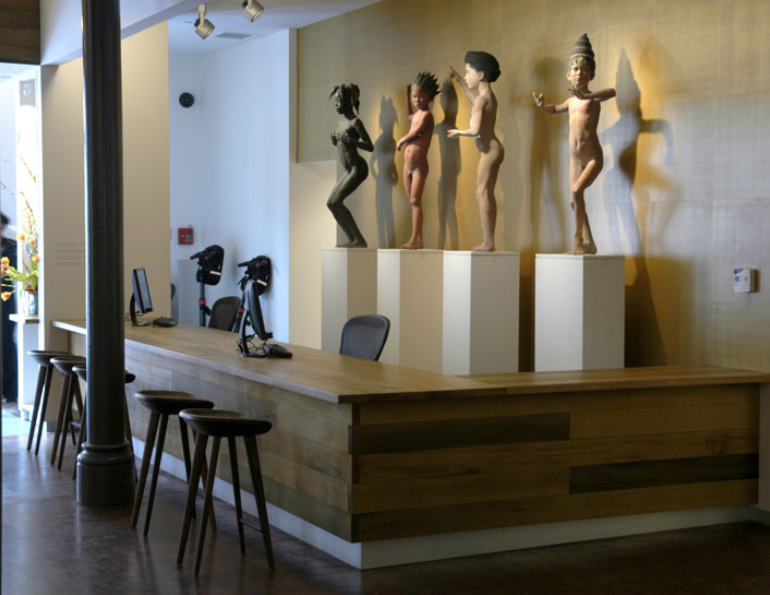 Judy Fox's sculptures in the lobby of 21c, Louisville. Photo courtesy of 21c.
Judy Fox's sculptures in the lobby of 21c, Louisville. Photo courtesy of 21c.
Can you tell me about how 21c is different than a museum?
A normal hotel will have a ballroom and a number of meeting rooms, which are all locked unless they’re rented to a client. All of our lobbies, ballrooms, and meeting rooms are exhibition spaces and the doors are always unlocked unless a client is renting one for a special event. So anyone off the street can come into any or all of the rooms depending on what's going on at the hotel. And I like to say that we're the only museum in America that is open 24 hours a day, every day of the year, free to the public. You see people off the sidewalk coming into the hotel at odd hours. As far as the financial model: Laura Lee and I own, just guessing, 90 percent of what's exhibited. We pull the exhibitions out of our collection and on occasion Alice Gray Stites, our curator, will borrow from an artist or a gallery (or less often an owner), like a museum would. And on occasion we exhibit a one-man show that's on tour or that we co-sponsored. So I guess that's very similar to the way museums work.
We collect only contemporary, and I think what does make us different than a classic museum is we don't collect modern works that are tremendously valuable, like oil paintings from centuries past—so we don't have these storage and exhibition limitations that a lot of museums do. We take some chances. We are the owners so if something happends we are the ones at risk. But we've really had very little problems or damage to objects or pieces. We don't put a Picasso or a Rembrandt out but we've never had anyone try to damage anything.
 Video gallery in 21c, Nashville. Photo courtesy of 21c.
Video gallery in 21c, Nashville. Photo courtesy of 21c.
Apart from being solely contemporary works, how would you characterize your collection? Is there a certain aesthetic or subject matter that draws you?
That's a really hard question. We don't have rules about what we will or will not do, though the collection is broadly international and very ethnically diverse. It's a lot of female work, not just Black American but South African, some Chinese, some Japanese, and some Turkish. We're never shopping for a particular thing. I’m one of the few art collectors who like art fairs. I like the energy level, I like seeing the all latest things in a concise space. My wife and I are very different in a lot of ways [laughs]. I walk through very quickly and things that catch my eye I stop to find out more about. She's more meticulous: she has a little map and she ticks it off. She loves to see everything, and she has more energy than I do. She'll go all day long every day, and I would rather race through and then take a break [laughs.]
Do you remember the first artwork that you ever acquired?
We're both in our second marriages and were collectors before we got married. Laura Lee was the director of the Speed museum in Louisville, and then I was after her. I was raised on a farm and went to art school at a regional college. I bought a Picasso lithograph poster when I was an art student—I do remember that. I don't know if Laura Lee remembers the first thing or not.
When did you realize that you wanted to start an art collection?
Well she had started a collection before she met me. And we were drawn to each other because we both love the arts, we both love travel, and although we came from different backgrounds, we have a deep interest in land preservation; we live on a farm now. True collectors don't buy because they need a piece for over the couch, we buy things that we have no idea where to put them. Then they end up in storage. We had a desire to find a way to share more than we could just at home. That's the reason we started the company.
 21c in Bentonville. Photo courtesy of 21c.
21c in Bentonville. Photo courtesy of 21c.
I read that you are stepping down as CEO and handing off the position to Craig Greenberg who's been the president. How do you see your involvement continuing from here on out?
I don't view my role as any different. Craig has been a very strong ally and a best friend, and titles seem to mean more in the corporate world than they do personally. I'm not handing down or stepping down; I think we're both stepping up. When we started we didn't have a board of directors. Laura Lee and I made all our own decisions. 21c was never meant to be a business. We didn't expect to have a thousand employees. Now I'm chairman of the board, which is a new role for me. I plan to continue seeking out new locations; we're building in Kansas City and we're looking for sites in Chicago, Miami, and New Orleans right now. So my work with Craig will continue as it has been. No matter what I'm doing or where I am, I'm always working, I'm always thinking about how a piece of art can be commissioned for a space, and how our hotels can do better based on the experiences that I'm having during my travels. I love my work. I can't imagine ever retiring. Now that we are a company, we joke that we didn't know the rules so it was pretty easy to break them. Now that we're growing and our passion is becoming corporate, the test is how to not lose the edge that we had when we weren’t a corporation. I guess that's my role: to keep it fresh and to keep it as close to the original concept as possible.
I have one last question for you and it doesn't have anything to do with 21c or art for that matter, but I've heard you’re on the US equestrian team, riding a cart that's pulled by horses. How does horse racing fit into all of this?
I was raised on a farm with horses. I rode a Quarter to herd cattle. I got away from it in college and to answer your question, I only started this 8 years ago. This is called combined driving, CDE. I joke that I'm the oldest and least experienced in the sport. Prince Phillip invented the sport about 50 years ago when he stopped playing polo but wanted a sport where you could still be with horses. You drive either a single horse, two horses, or four horses. Four horses is the most difficult and I’m driving two. The first day of the event you drive the horses in dressage, in patterns, kind of like figure skating. The second day is cross-country: 15 kilometers, timed, and instead of jumps they've created hazards, like seven or eight mazes that you have to make your way through.
I think I saw a photograph of you driving a horse through what looks like a giant mud pit.
[Laughs.] Horse sports are based on military history. So dressage movements are based on movements that one might have had to learn to be successful cavalrymen. Sometimes you're required to use your left hand, and that stems from needing to use your right hand to hold a gun. Horses are basic to our history of civilization. They were critical in military, and critical to the settling of the West in America and Australia. It's interesting to think about how important horses have been to us. I saw this sport about nine years ago and decided, hey, I think I could do that . I had a horse accident earlier and have an artificial hip because of it so I had stopped riding. So now I can be with horses and still enjoy them. It's not less dangerous in any way but at least it's not uncomfortable. I have a lot of passion [laughs.]











